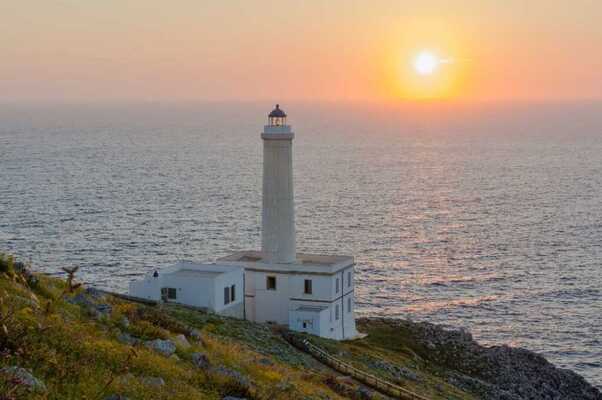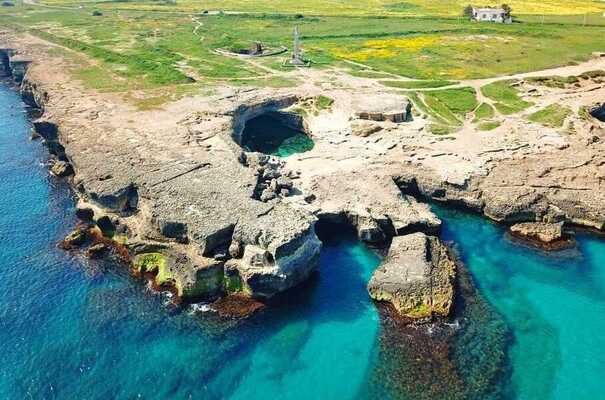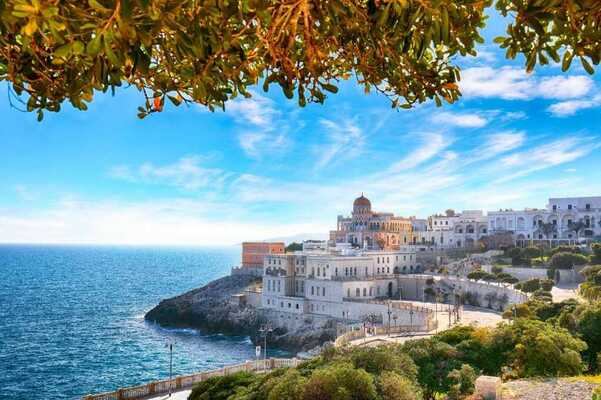Santa Maria di Leuca: de finibus terrae
The southernmost inhabited center of the entire province, Santa Maria di Leuca, has a precise origin.
The name “Leuca” was given by ancient Greek sailors who saw the place as illuminated by the sun and therefore leukos, white. Instead, another name with which it is associated was born from the Romans, namely “de finibus terrae“. The name “Santa Maria” was wanted by Saint Peter who, having landed here, dedicated it to the Virgin.

The Finis Terrae Sanctuary
It was born on an ancient temple dedicated to the goddess Minerva. The interior of the sanctuary has a single nave with six side altars; the facade of the church is divided in two by an entablature. The lower area, enriched with epigraphs and coats of arms, is divided into five compartments by four pilasters, two of which end with two statues. In the central part, the entrance portal opens, while two other, smaller ones are located at the two ends.
The lighthouse of Santa Maria di Leuca
Santa Maria di Leuca lighthouse is located on Punta Melisio. The octagonal tower is located 47 meters above ground level and 102 meters above sea level.
You can reach the top via a staircase made up of 254 steps and admire the breathtaking view of the two seas, with the mountains of Albania to the east, the mountains of Calabria to the west and the island of Corfù to the south.
Leuca’s coast presents a different characterization: that on the Adriatic (East) is high and jagged, that on the Ionian (West) lower and more homogeneous.

The caves
The eastern coast is home to numerous caves such as Cazzafri, Pozzo, Brigante, and finally the Ciolo inlet.
On the coast road that leads to Gallipoli near Punta Ristola, you come across the Porcinara Cave and finally the Punta del Diavolo, so called because of the dark rumbles; Neolithic finds have been discovered here.
On the western coast we find the Cave of the Giants, the Child and the Nativity Scene, so called due to the presence of stalactites that recall the Nativity.
The village festivals
Of course, the town’s festivals cannot be missed. Every 15th August the Madonna of Santa Maria di Leuca is celebrated with a procession through the streets of the town, up to the port where she is embarked on a fishing vessel.
The particular geographical position of Santa Maria has favored the contact of various Mediterranean populations and the creation of beautiful nineteenth-century houses and villas which are opened to the public on a Sunday in May. Here, inside each villa, the historical and architectural characteristics are illustrated. Furthermore, the guided tour includes the tasting of gastronomic specialties or architectural exhibitions. Usually, access is free or established by the owner.
How to get to Santa Maria di Leuca
By plane:
- Brindisi airport (130km)
- Bari airport (250km)
By train:
Arrive by train to Lecce, and from there use the local railway networks until you reach Gagliano del Capo (5km from Santa Maria di Leuca, another alternative, once in Lecce, can be the excellent Salento by Bus service present during the entire summer period.
By car:
- From Brindisi: SS613 towards Lecce. Before arriving in Lecce, take the SS694 Tangenziale Ovest junction, after a few km take the SS101 junction for Gallipoli. Continue on the SS101 and follow the signs for Santa Maria di Leuca
- From Bari: SS16 towards Brindisi and continue to Lecce without ever changing direction once you reach the SS613 follow the directions above.

Punta Palascia: useful information
Punta Palascia, a few kilometers from Lecce, is a place famous for its lighthouse, counted among the five most important in the Mediterranean, from which it is possible to admire breathtaking scenery framed by uncontaminated nature and expanses of water.

Salento Caves
Salento is a peninsula full of numerous and evocative caves scattered here and there, which can be visited mainly by sea. They all deserve to be visited for the colors or the particular shape of the rocks, creating a beautiful journey inside them, rich in history and nature. Even those who are passionate about trips, excursions and diving, here, can enjoy beautiful glimpses of rock full of niches and cliffs.

Santa Cesarea Terme
Santa Cesarea Terme represents one of the most popular Salento destinations for travelers seeking relaxation and well-being. This is thanks to the beneficial thermal waters that flow from the subsoil which are, in fact, a true elixir of beauty and health.
